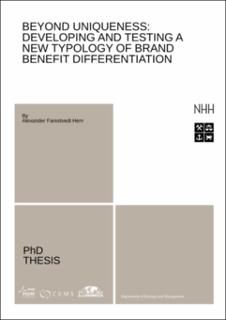| dc.description.abstract | Customer-based brand equity (CBBE) theory, the dominant theory of branding, holds that unique associations are the main source of brand differentiation (Keller, 1993, 2012). However, the focus on unique associations as the main strategy for developing brand equity has recently been called into question. The purpose of this thesis is to challenge and extend the traditional view by suggesting that uniqueness is only one of several forms of differentiation. Drawing on network theories of human memory, the thesis develops a fourfold typology of brand benefit differentiation.
The thesis comprises three articles (one conceptual study and two empirical studies) and an introductory chapter. The objectives of the three articles were (1) to identify different dimensions of associative networks as the basis for a new typology of benefit differentiation; (2) to investigate whether new types of differentiation could be identified by exploring association maps for well-known brands in different product categories; and (3) to investigate the effects of the different types of differentiation on benefit evaluation and brand attachment.
Article 1 describes a new typology for brand benefit differentiation. In addition to uniqueness (referred to here as categorical differentiation), three new types are identified: graded, instrumental, and structural differentiation. It is argued that the meaning of benefits may vary across brands according to the strength of benefit associations (graded differentiation); in terms of how much associations contribute to the meaning of benefits (instrumental differentiation); and in terms of how such associations are structured or interlinked (structural differentiation). All of these variations in benefit networks may lead to differentiated meanings. The findings in Article 2 (N = 164) provide preliminary support for the typology by identifying all four types of benefit differentiation in aggregated association maps. In Article 3 (N = 265), the findings show that structural and graded differentiation have positive effects on benefit evaluation and brand attachment, respectively, while categorical differentiation (uniqueness) has negative effects on both benefit evaluation and brand attachment. These findings support and extend recent critiques of CBBE theory’s focus on uniqueness.
To our knowledge, these studies are the first to identify and test several types of differentiation at the level of benefits, and the first to use individual association maps to explore brand differentiation. The findings confirm the need to revise and extend CBBE theory. Most importantly, the results identify new opportunities for brand differentiation. | nb_NO |
